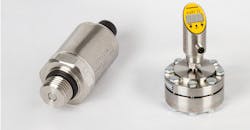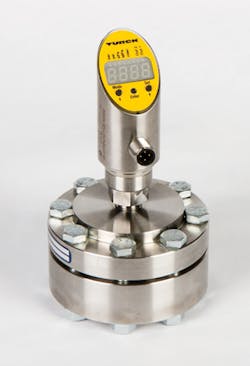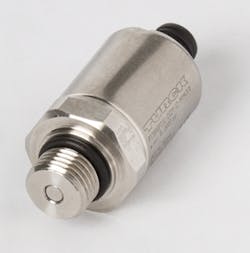4 Conditions to Consider When Selecting a Pressure Sensor
A failed or damaged pressure sensor can lead to unexpected downtime and costs. To reduce these risks, engineers must consider how the various challenges of an application will affect sensors.
Measurement requirements are just one of many aspects of pressure sensing that need to be considered to correctly measure and interpret pressure. In many circumstances, application challenges are not considered until there is either a misreading of the pressure or some type of sensor damage has occurred.
Four of the common application challenges that impact pressure sensors are related to:
- Media
- Pressure
- Transients
- Condensation
This article will examine these challenges and explore how modern sensor design and technology can help overcome them.
Application challenge #1: The media being measured clogs the sensor.
In extreme applications, accessories such as a diaphragm seal can be added to isolate the sensor from the media being measured. When choosing a diaphragm seal, look for designs with large open areas that will resist clogging, and a cleanout port to facilitate the removal of material buildup.
While pressure measurement is a fairly straightforward concept, the media which is being measured can vary in numerous ways. In most instances, the media is as ideal as clean air or water, but there are applications where media can have debris mixed in, such as contaminated coolant or slurries. If not managed properly, the media can clog the measuring cell on the pressure sensor, causing the sensor to improperly measure the force being applied. This often results in damage to system components.
The ideal solution is either to filter the media before it reaches the sensor or isolate the media from the sensor. In many cases, filtering the media is not possible or practical, but engineers can solve this problem through sensor product selection.
In extreme applications, accessories such as a diaphragm seal can be added. Diaphragm seals are liquid-filled devices that isolate the sensor from the media being measured. Look for designs with large open areas that will resist clogging. Another feature to look for is a cleanout port, which allows a separate connection specifically designed to facilitate removing material buildup.
In some applications, using a diaphragm seal is not an option. In these cases, select a sensor that allows unobstructed access to the measuring cell. This design will not eliminate clogs, but can minimize the likelihood of clogs that cause unwanted system downtime.
Application challenge #2: The pressure sensor has to measure corrosive media.
Another common issue for pressure sensors is corrosive media, which can destroy a sensor if the right materials are not used. In addition, temperature fluctuations can cause different reactions between media and the wetted materials of the sensor that can lead to the breakdown of the wetted materials. This will eventually cause the sensor to fail and become inoperable.
For adequate resistance to most corrosive materials, engineers should look for products that feature wetted materials made from stainless steel. Products made with all stainless materials are normally welded, which eliminates an elastomer seal thereby preventing long-term problems with chemical compatibility. When an all-stainless design is not an option, look for other durable materials such as measuring cells made with aluminum oxide AL2O3 ceramic, and sealing materials that are compatible with the media used.
Application challenge #3: Dynamic pressure and pressure transients may occur.
Many of today’s pressure sensors offer an integrated snubber that can reduce the effect of pressure spikes and reduce potential leak points. Sensors with snubbers built in, like the one shown, offer an advantage because the snubber cannot accidentally be removed during sensor maintenance or replacement.
Pressure transients, sometimes referred to as water hammers or pressure spikes, are common in liquid media. A number of factors can cause these transient spikes, such as the sudden opening or closing of valves, pumps turning on or off, or an object suddenly disrupting the flow of the media. This sudden shock to the system often results in a pressure spike that is many times higher than the normal system pressure. The spike in pressure has the potential to damage system components.
One of the best ways to avoid pressure spikes is to eliminate them before they become a problem. A common solution is using soft start systems for pump control. Instead of the instantaneous flow of media, the soft start allows a gradual flow to occur, thereby minimizing the potential for a pressure spike. Unfortunately, not all applications can use this approach.
When a soft start system isn’t possible, the easiest solution is to add a pressure snubber. This is an accessory installed between the process media and the sensor that is designed to dissipate the pressure spike.
While there are different methods of pressure-snubber construction, the concept is to help take the high-pressure spike and distribute it more evenly, thereby lowering pressures to the measuring cell. Many of today’s pressure sensors offer an integrated snubber that can reduce the effect of pressure spikes. A sensor with an included snubber is an advantage because the snubber cannot accidentally be removed during sensor maintenance or replacement. The design also reduces potential leak points as it is an internal component of the sensor.
Application challenge #4: Condensation and moisture build inside the sensor.
The potential for condensation is commonly overlooked when specifying a pressure sensor because it often happens intermittently. Condensation can build up on the inside of the sensor when conditions are right, such as measuring cold media in warm ambient conditions. In this example, the temperature differential between the two can lead to moisture buildup on the internal area of the sensor. This condensation can cause the electronics to operate outside of the normal function, short, or fail completely.
The risk of condensation inside the pressure sensor can sometimes be mitigated by reducing the influence of temperature in the application. This can be done by physically moving the sensor or creating an isolation between the sensor and the media being measured.
Another option is to choose sensors designed to work with these challenging applications. There are many design options for accomplishing this, and one example is filling the sensor housing with viscous gel. This gel works to keep condensation from forming on the internal components while still allowing the sensor to have an atmospheric reference vent. Engineers who anticipate condensation and moisture may be an issue should look for a pressure sensor with a gel-filled housing.
There are numerous challenges that can affect the accuracy and reliability of pressure measurement. One of the best ways to ensure that you are always receiving accurate and reliable pressure measurement is by eliminating the conditions that will disrupt your expected results, and choosing a pressure sensor designed to withstand the particular challenges of your application.
By looking at the application and implementing the appropriate sensor technology, engineers can successfully measure and interpret pressure, as well as save frustrations, downtime, and money.
Rich Tallant is a senior product manager and Kyle Horsman is a product specialist with Turck's sensors division. For more information on pressure sensors, contact Turck at (800) 554-7769 or via e-mail.



